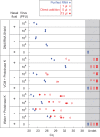Open-source RNA extraction and RT-qPCR methods for SARS-CoV-2 detection
- PMID: 33534838
- PMCID: PMC7857565
- DOI: 10.1371/journal.pone.0246647
Open-source RNA extraction and RT-qPCR methods for SARS-CoV-2 detection
Abstract
Re-opening of communities in the midst of the ongoing COVID-19 pandemic has ignited new waves of infections in many places around the world. Mitigating the risk of reopening will require widespread SARS-CoV-2 testing, which would be greatly facilitated by simple, rapid, and inexpensive testing methods. This study evaluates several protocols for RNA extraction and RT-qPCR that are simpler and less expensive than prevailing methods. First, isopropanol precipitation is shown to provide an effective means of RNA extraction from nasopharyngeal (NP) swab samples. Second, direct addition of NP swab samples to RT-qPCRs is evaluated without an RNA extraction step. A simple, inexpensive swab collection solution suitable for direct addition is validated using contrived swab samples. Third, an open-source master mix for RT-qPCR is described that permits detection of viral RNA in NP swab samples with a limit of detection of approximately 50 RNA copies per reaction. Quantification cycle (Cq) values for purified RNA from 30 known positive clinical samples showed a strong correlation (r2 = 0.98) between this homemade master mix and commercial TaqPath master mix. Lastly, end-point fluorescence imaging is found to provide an accurate diagnostic readout without requiring a qPCR thermocycler. Adoption of these simple, open-source methods has the potential to reduce the time and expense of COVID-19 testing.
Conflict of interest statement
The authors have declared that no competing interests exist.
Figures








Similar articles
-
Simple, Inexpensive RNA Isolation and One-Step RT-qPCR Methods for SARS-CoV-2 Detection and General Use.Curr Protoc. 2021 Apr;1(4):e130. doi: 10.1002/cpz1.130. Curr Protoc. 2021. PMID: 33905620 Free PMC article.
-
A novel One-pot rapid diagnostic technology for COVID-19.Anal Chim Acta. 2021 Apr 15;1154:338310. doi: 10.1016/j.aca.2021.338310. Epub 2021 Feb 11. Anal Chim Acta. 2021. PMID: 33736798 Free PMC article.
-
Comparison of SARS-CoV-2 PCR-Based Detection Using Saliva or Nasopharyngeal Swab Specimens in Asymptomatic Populations.Microbiol Spectr. 2021 Sep 3;9(1):e0006221. doi: 10.1128/Spectrum.00062-21. Epub 2021 Aug 25. Microbiol Spectr. 2021. PMID: 34431689 Free PMC article.
-
Clinical evaluation of a multiplex real-time RT-PCR assay for detection of SARS-CoV-2 in individual and pooled upper respiratory tract samples.Arch Virol. 2021 Sep;166(9):2551-2561. doi: 10.1007/s00705-021-05148-1. Epub 2021 Jul 14. Arch Virol. 2021. PMID: 34259914 Free PMC article.
-
Comparing two sample pooling strategies for SARS-CoV-2 RNA detection for efficient screening of COVID-19.J Med Virol. 2021 May;93(5):2805-2809. doi: 10.1002/jmv.26632. Epub 2021 Mar 11. J Med Virol. 2021. PMID: 33107614
Cited by
-
Point-of-Care Diagnostic Tools for Surveillance of SARS-CoV-2 Infections.Front Public Health. 2021 Nov 25;9:766871. doi: 10.3389/fpubh.2021.766871. eCollection 2021. Front Public Health. 2021. PMID: 34900912 Free PMC article. Review.
-
UnCovid: A versatile, low-cost, and open-source protocol for SARS-CoV-2 RNA detection.STAR Protoc. 2021 Dec 17;2(4):100878. doi: 10.1016/j.xpro.2021.100878. Epub 2021 Sep 25. STAR Protoc. 2021. PMID: 34604812 Free PMC article.
-
Graph data science and machine learning for the detection of COVID-19 infection from symptoms.PeerJ Comput Sci. 2023 Apr 10;9:e1333. doi: 10.7717/peerj-cs.1333. eCollection 2023. PeerJ Comput Sci. 2023. PMID: 37346701 Free PMC article.
-
Unlocking SARS-CoV-2 detection in low- and middle-income countries.Cell Rep Methods. 2021 Oct 21;1(7):100093. doi: 10.1016/j.crmeth.2021.100093. eCollection 2021 Nov 22. Cell Rep Methods. 2021. PMID: 34697612 Free PMC article.
-
Detection and molecular characterisation of subtype B avian metapneumovirus in commercial chickens and co-infection with bacteria pathogens in Nigeria.Trop Anim Health Prod. 2025 Jun 4;57(5):243. doi: 10.1007/s11250-025-04498-1. Trop Anim Health Prod. 2025. PMID: 40465030
References
-
- Mervosh S, Fernandez M. ‘It’s Like Having No Testing’: Coronavirus Test Results Are Still Delayed. New York Times. 7 August 2020. Available: https://www.nytimes.com/2020/08/04/us/virus-testing-delays.html
-
- Centers for Disease Control and Prevention. CDC 2019-novel coronavirus (2019-nCoV) real-time RT-PCR diagnostic panel for emergency use only instructions for use. Atlanta; 2020.
-
- Akst J. RNA Extraction Kits for COVID-19 Tests Are in Short Supply in US. Sci. 2020. Available: https://www.the-scientist.com/news-opinion/rna-extraction-kits-for-covid...
Publication types
MeSH terms
Substances
Grants and funding
LinkOut - more resources
Full Text Sources
Other Literature Sources
Medical
Research Materials
Miscellaneous

